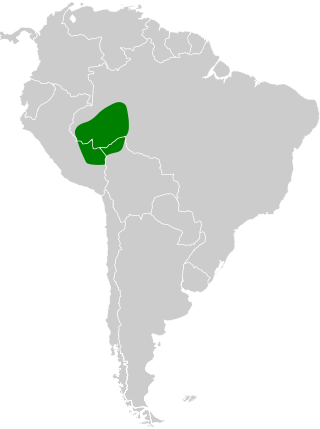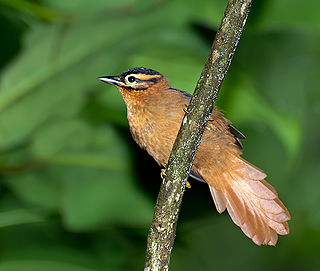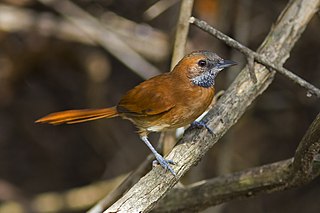
The royal cinclodes is a Critically Endangered passerine bird in the Furnariinae subfamily of the ovenbird family Furnariidae. It is found in Bolivia and Peru.

The semicollared puffbird is a species of near-passerine bird in the family Bucconidae, the puffbirds, nunlets, and nunbirds. It is one of seven species of the genus Malacoptila. It is found in Bolivia, Brazil, and Peru.

The buff-winged cinclodes is a species of bird in the Furnariinae subfamily of the ovenbird family Furnariidae. It is found in Argentina, Brazil, Chile, Paraguay, Uruguay and as a vagrant on the Falkland Islands.

Olrog's cinclodes is a species of bird in the Furnariinae subfamily of the ovenbird family Furnariidae. It is endemic to Argentina.

The Peruvian seaside cinclodes or surf cinclodes is a species of bird in the Furnariinae subfamily of the ovenbird family Furnariidae. It is endemic to Peru.

The bay hornero or pale-billed hornero is a species of bird in the Furnariinae subfamily of the ovenbird family Furnariidae. It is found in Brazil, Colombia, Peru, and possibly Eucador.

The campo miner is a Vulnerable species of bird in the subfamily Sclerurinae, the leaftossers and miners, of the ovenbird family Furnariidae. It is found in Bolivia and Brazil, and as a vagrant in Paraguay.

The sharp-billed treehunter, sometimes called the sharp-billed xenops, is a species of bird in the Furnariinae subfamily of the ovenbird family Furnariidae. It is found in Argentina, Brazil, Paraguay, and Uruguay.

The black-capped foliage-gleaner is a species of bird in the Furnariinae subfamily of the ovenbird family Furnariidae. It is found in Argentina, Brazil, and Paraguay.

The grey-crested cacholote is a species of bird in the Furnariinae subfamily of the ovenbird family Furnariidae. It is found in Bolivia, Brazil, and Paraguay.

The cinereous-breasted spinetail is a species of bird in the Furnariinae subfamily of the ovenbird family Furnariidae. It is found in Bolivia, Brazil, Paraguay, and Peru.

The hoary-throated spinetail is a Critically Endangered bird species in the Furnariinae subfamily of the ovenbird family Furnariidae. It is found in Brazil and Guyana.

The rock earthcreeper is a species of bird in the Furnariinae subfamily of the ovenbird family Furnariidae. It is found in Argentina and Bolivia, and as a vagrant in Chile.

The Chaco earthcreeper is a species of bird in the Furnariinae subfamily of the ovenbird family Furnariidae. It is found in Argentina, Bolivia, and Paraguay, and as a vagrant in Brazil.

The scale-throated earthcreeper is a species of bird in the Furnariinae subfamily of the ovenbird family Furnariidae. It is found in Argentina, Bolivia, Chile, Peru, and possibly Uruguay.

The Bolivian earthcreeper is a species of bird in the Furnariinae subfamily of the ovenbird family Furnariidae. It is found in Argentina and Bolivia.

The rufous-tailed xenops is a species of bird in the Furnariinae subfamily of the ovenbird family Furnariidae. It is found in Bolivia, Brazil, Colombia, Ecuador, Guyana, Peru, Suriname, Venezuela, and possibly French Guiana.

Zimmer's woodcreeper is a Near Threatened species of bird in the subfamily Dendrocolaptinae of the ovenbird family Furnariidae. It is found in Brazil, Colombia, and Peru.

The Orinoco piculet is a species of bird in subfamily Picumninae of the woodpecker family Picidae. It is found in Brazil, Colombia, and possibly Venezuela.

The Rio Orinoco spinetail, or Orinoco spinetail, is a Near Threatened species of bird in the Furnariinae subfamily of the ovenbird family Furnariidae. It is found in Venezuela and possibly Colombia.
























